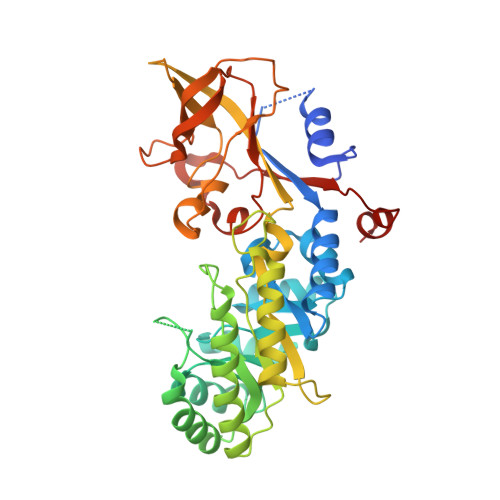Altering the reaction specificity of eukaryotic ornithine decarboxylase.
Jackson, L.K., Brooks, H.B., Osterman, A.L., Goldsmith, E.J., Phillips, M.A.(2000) Biochemistry 39: 11247-111257
- PubMed: 10985770
- DOI: https://doi.org/10.1021/bi001209s
- Primary Citation of Related Structures:
1F3T - PubMed Abstract:
Ornithine decarboxylase (ODC) catalyzes the first committed step in the biosynthesis of polyamines, and it has been identified as a drug target for the treatment of African sleeping sickness, caused by Trypanosoma brucei. ODC is a pyridoxal 5'-phosphate (PLP) dependent enzyme and an obligate homodimer. X-ray structural analysis of the complex of the T. brucei wild-type enzyme with the product putrescine reveals two structural changes that occur upon ligand binding: Lys-69 is displaced by putrescine and forms new interactions with Glu-94 and Asp-88, and the side chain of Cys-360 rotates into the active site to within 3.4 A of the imine bond. Mutation of Cys-360 to Ala or Ser reduces the k(cat) of the decarboxylation reaction by 50- and 1000-fold, respectively. However, HPLC analysis of the products demonstrates that the mutant enzymes almost exclusively catalyze a decarboxylation-dependent transamination reaction to form pyridoxamine 5-phosphate (PMP) and gamma-aminobutyraldehyde, instead of PLP and putrescine. This side reaction arises when the decarboxylated substrate intermediate is protonated at C4' of PLP instead of at the C(alpha) of substrate. For the reaction catalyzed by the wild-type enzyme, this side reaction occurs infrequently (<0.01% of the turnovers). Single turnover analysis and multiwavelength stopped-flow spectroscopic studies suggest that for the mutant ODCs protonation at C4' occurs either very rapidly or in a concerted reaction with decarboxylation and that the rate-limiting step in the steady-state reaction is Schiff base hydrolysis/product release. These studies demonstrate a role for Cys-360 in the control of the C(alpha) protonation step that catalyzes the formation of the physiological product putrescine. The results further provide insight into the mechanism by which this class of PLP-dependent enzymes controls reaction specificity.
Organizational Affiliation:
Department of Pharmacology and Department of Biochemistry, The University of Texas Southwestern Medical Center at Dallas, 5323 Harry Hines Boulevard, Dallas, Texas 75390-9041, USA.
















